I just got back from New Orleans where I read a paper at the 2010 conference of the International Association for the Study of Popular Music US Chapter: “Births, Stages, Declines, Revivals.” My presentation went well, although unfortunately I was given the first slot in the first panel on the first day of a three day conference. (8:30 AM on Friday morning!) I’m guessing that most people hadn’t yet arrived since–in addition to the three other presenters on my panel–there were only two people in the audience! Oh well.
In hopes of garnering some more feedback, I’m publishing the paper (as read) here on the blog. As usual, this remains a work in progress.
Click here to download a PDF version of the paper. (Slides and visual examples appear at the end of the PDF.) Or, follow the jump to read the html version.
Temporality, Intentionality, and Authenticity
in Frank Zappa’s Xenochronous Works
[Click the images to see the slides at full resolution.]
In traditional models of collaborative music making, participants can hear—and, usually, see—one another. Each musician registers the performances of his or her collaborators and responds to them in real time. Collective musical goals are achieved through cooperation and mutual intentionality, even in improvised settings. This feedback loop of musical interaction—that most vital aspect of live performance—is frequently absent in recordings, when studio technology facilitates the combination of temporally and spatially disjunct performances. Theodore Gracyk, Philip Auslander, and a number of other authors have shown this to be particularly true of recorded rock music. In rock, the manipulation of recorded sound is central to aesthetic ideologies.
Lee B. Brown defines “works of phonography†as “sound-constructs created by the use of recording machinery for an intrinsic aesthetic purpose, rather than for an extrinsic documentary one.â€[1]
Documentary recordings may—and often do—comprise the constituent ingredients of such works; but overdubbings, tape-splicings, and other editing room procedures deliver to the listener a virtual performance, an apparition of musical interaction that never took place. Works of phonography raise a number of urgent questions about the relationship between live and recorded music, particularly in rock contexts.
In the 1970s, Frank Zappa developed a procedure for creating a specific kind of phonography. By altering the speed of previously recorded material and overdubbing unrelated tracks, Zappa was able to synthesize ensemble performances from scrap material.
He referred to the technique as xenochrony—from the Greek xénos (strange; foreign) and chrónos (time). Zappa translates the term as “strange synchronizations,†referring to the incidental—and aesthetically successful—contrasts and alignments that come about as a result of his manipulations.
Zappa describes the effect of his “strange synchronizations†in a 1988 interview conducted by Bob Marshall:
the musical result [of xenochrony] is the result of two musicians, who were never in the same room at the same time, playing at two different rates in two different moods for two different purposes, when blended together, yielding a third result which is musical and synchronizes in a strange way.[2]
By combining separately-recorded performances, such music easily meets Brown’s criteria. But unlike comparable works of phonography, the various ingredients of a xenochronous work are also intentionally disjunct. Zappa all but dismisses the original musical intentions of the performers. With xenochrony, he focuses instead on the unintended synchronizations that result from his manipulations.
In many cases, rock artists and producers mask their methods. Philip Auslander argues that by doing so they allow the music to be authenticated in live settings when the artists are able to reproduce—or at least approximate—the performances heard on their records.[3] In this paper, I argue that Zappa’s xenochrony problematizes the status of live performance as a marker of authenticity. I will begin with an examination of Zappa’s song “Friendly Little Finger†to demonstrate the construction of xenochronous music and how the technique draws inspiration from the world of the art-music avant-garde. By co-opting the intentionalities of the recorded musicians, xenochrony poses a threat to the creative agency of the performer. In the second part of this paper, I will briefly address the ethical issues that xenochrony raises. Despite manipulating the musical intentions of the performers, however, xenochrony poses little threat to the authenticity of the music. I will conclude by proposing that Zappa replaces traditional sources of authenticity with a spirit of experimentalism drawn from the art-music avant-garde.
I. Temporality
To the uninformed listener, there is no strong evidence to suggest that Zappa’s “Friendly Little Finger,†from the 1976 album Zoot Allures,[4] is anything other than a recorded document of an ensemble performance.
The piece begins with a brief introduction featuring a repeated riff performed on guitar, marimba, and synthesizer. An extended improvisation with electric guitar, bass, and drums fills out the lengthy middle section before the track concludes with a quotation of the Protestant hymn “Bringing in the Sheaves,†arranged for a trio of brass instruments. Despite its apparent normalcy, however, “Friendly Little Finger†combines materials from four distinct sources spanning three years of Zappa’s career.
The primary recording—a guitar solo with a droning bass accompaniment—was recorded in the dressing room of the Hofstra University Playhouse as a warm-up before a performance on October 26, 1975. Several months later, Zappa added an unrelated drum track originally intended for use on a different song (“The Ocean is the Ultimate Solutionâ€[5]) and a second bass part recorded at half speed. These three recordings, all appearing in the middle solo section, comprise the xenochronous core of the piece. To this, Zappa superimposed two additional recordings. The introduction comes from the same session as the added bass part, and the coda was recorded several years earlier, during a session for the song “Wonderful Wino.”
As Example 1 makes clear, the result of Zappa’s editing is a moderately dense network of temporally disjunct recordings. How is it that such seemingly disparate recordings happened to come together in this way? What inspired Zappa to take such an approach to manipulating recorded sound? Of course, examples of overdubbing in American popular music can be found at least as far back as the 1940s—recall Sidney Bechet’s One Man Band recordings in which each instrument was performed separately by Bechet himself. But while such tricks had become old hat by the mid 1970s, xenochrony stands out for it also has obvious ties to the twentieth-century art-music avant-garde.
Despite his continuing reputation as a popular musician, Zappa was remarkably well read in the theoretical discourse surrounding avant-garde art music, particularly with regards to musique concrète and tape music. He expressed an ongoing interest in John Cage’s chance operations, for example, trying them out for himself by physically cutting recorded tapes and rearranging the pieces at random for the 1968 album Lumpy Gravy.[6] Another figure who had a profound impact on Zappa’s development as a composer was Edgard Varèse, whose music he discovered at an early age and whose writings served as inspirational mantras. Given this fascination with the avant-garde, xenochrony may be best understood as a conscious attempt by Zappa to model himself on these influential figures. His own approach to music and composition would therefore require an analogous theoretical foundation.
Xenochrony is closely tied to Zappa’s conception of temporality. Zappa often described time as a simultaneity, with all events occurring at once instead of chronologically. Toward the end of his life, in an oft-quoted conversation with cartoonist Matt Groening, Zappa explained that the idea was rooted in physics:
I think of time as a spherical constant, which means that everything is happening all the time. […] They [human beings] take a linear approach to it, slice it in segments, and then hop from segment to segment to segment until they die, and to me that is a pretty inefficient way of preparing a mechanical ground base for physics. That’s one of the reasons why I think physics doesn’t work. When you have contradictory things in physics, one of the reasons they became contradictory is because the formulas are tied to a concept of time that isn’t the proper model.[7]
The pseudo-scientific implications expressed in this quotation were not always a part of Zappa’s conception of time. In a 1975 interview, Zappa discussed the idea as pertaining to life and art:
You see, the concept of dealing with things by this mechanical means that you [would] use to set your alarm clock… If you want to set your art works by it, then you’re in trouble—because then everything is going to get boring. So I’m working on a different type of a time scale.[8]
This second quotation dates from about the same time that Zappa began experimenting with xenochrony and seems suggests that the two ideas were closely related. Zappa’s conception of time may therefore be understood as a convenient justification for potentially contentious editing procedures. Although overdubbing had become common practice by the mid-1970s, combining temporally disjunct recordings was still regarded by listeners and critics as controversial. By reconfiguring the very concept of time, Zappa skirts the issue.
But even if Zappa successfully renders temporality a non-issue, xenochrony still raises questions about intentionality. Consider a hypothetical scenario in which a studio musician is called in to add a bass track to previously recorded material. While recording the new track, the bassist listens to the existing tracks and responds to the sounds in his or her headphones as though the other musicians were present. (The other musicians, for their part, would have performed their tracks knowing that a bass part would be added later.) Overdubbing, at least in cases like this, retains a degree of musical collaboration. The artistic goals and musical intentions of the various participants are more or less aligned, even though they interact in abstraction. Xenochrony, however, dispenses with intentionality altogether. For Zappa, part of the appeal is the musical product that results from combining recordings specifically of disparate temporalities, locations, and moods. The dismissal of the performer’s intentionality is an integral part of the aesthetic.
II. Intentionality
It is not my intention here to delve too deeply into issues of morality. Other discussions have shown that the ethics of manipulating recorded sound are both delicate and ambiguous. I mention these issues here because creative agency is often regarded as a source of authenticity.
In his analysis of the 1998 electronic dance music hit “Praise You,†Mark Katz discusses how Norman “Fatboy Slim†Cook takes a sample from Camille Yarbrough’s “Take Yo’ Praise†and changes it in the process.[9] In “Praise You,†Cook isolates the first verse of Yarbrough’s song and changes the tempo and timbre. Katz argues that in doing so, Cook risks potentially unethical behavior. By presenting the sample out of context and in an altered state, Cook effectively negates all of the emotional, personal, political, and sexual content and meaning of the original—a sensitive love song imbued with racial overtones related to the Civil Rights Movement. Cook therefore presents a threat to Yarbrough’s artistic agency. Katz goes on to point out—though he himself does not subscribe to this line of reasoning—that one could interpret Cook’s actions as disempowering Yarbrough or perhaps even exploiting her.
Zappa takes similar risks with xenochrony. Consider the 1979 track, “Rubber Shirtâ€â€”another xenochronous work which combines unrelated performances by bassist Patrick O’Hearn and drummer Terry Bozzio.
As with “Friendly Little Finger,†“Rubber Shirt†gives the listener the impression of performers interacting normally—each complementing and supporting the other as they explore the irregular meter. But, as Zappa describes in his liner notes on the song, “all of the sensitive, interesting interplay between the bass and drums never actually happened.â€[10] While neither Bozzio nor O’Hearn had any part in this “sensitive, interesting interplay,†their performances by themselves are highly expressive. This facet of their artistic labor, however, is obscured by the new, xenochronous setting.
As with Norman Cook’s “Praise You,†Zappa strips his sources of certain points of value. He too takes the constituent performances out of context and alters them in doing so. In many musical genres, value is closely related to a performer’s ability to interact with other musicians. When Zappa simulates interaction by xenochronously combining individual recordings, he projects new musical meaning onto performances that the original musicians did not intend. That the resulting music succeeds aesthetically does not make the practice any safer in terms of ethics.
Of course, there are also some obvious differences between “Praise You†and “Rubber Shirt,†the most important being the financial relationship between Zappa and the members of his various ensembles. O’Hearn and Bozzio were paid employees, hired to perform Zappa’s music. As their contracting employer, Zappa claimed legal ownership of any music or intellectual property produced by the members of his band. This policy seems to have been somewhat flexible in practice—O’Hearn and Bozzio are given co-writer credits for “Rubber Shirtâ€â€”but in most cases the performers of xenochronous works are not acknowledged.
Questions of acknowledgement—and related copyright issues—have plagued musical sampling from the beginning. But again, xenochrony complicates the issue. Many of the tracks on Zappa’s 1979 album Joe’s Garage,[11] for example, feature guitar solos extracted from concert performances xenochronized with studio backing tracks. All of the audible musicians are credited in the liner notes. But what of the musicians that aren’t audible? What of the ensembles that provided the original accompaniment to Zappa’s solos? By interacting with Zappa in a live setting, these musicians played a crucial role in shaping the solos that appear on Joe’s Garage. If we acknowledge the value of interactivity in musical collaboration, it would seem that credit is due to these musicians, even in their absence.
III. Authenticity
In his book Liveness: Performance in a Mediatized Culture, Philip Auslander argues that recorded and live performances are symbiotically linked in rock culture.[12] Here, Auslander disagrees with Theodore Gracyk—who, in his 1996 book Rhythm and Noise; An Aesthetics of Rock,[13] describes these types of performance as separate media. Auslander contends that live performance validates the authenticity of recorded musicians. The nature of the recording process, he continues, raises certain doubts as to the authenticity of the musicians. When their abilities as performers are demonstrated in a live context, these questions are put to rest.[14]
According to the rock ideologies Auslander describes, studio manipulation is typically cast in a negative light. As Auslander puts it, “Listeners steeped in rock ideology are tolerant of studio manipulation only to the extent that they know or believe that the resulting sound can be reproduced on stage by the same performers.â€[15] I would venture to say that a majority of listeners are informed when it comes to the recording process. Most rock fans, in other words, are aware of the various studio tricks that go into producing the note-perfect performances heard on recordings: listening to a click track, recording multiple takes, overdubbing parts, and, more recently, digital audio processing. Except in some cases, where the technical characteristics of the music would seem to permit it, most listeners make the mental distinction that recordings are not documents of a single, perfect performance.
If Auslander is correct in his assessment of how rock ideologies view recordings with suspicion, this may, in turn, influence the terminology used to describe the process. Fans, critics, and journalists alike all speak of artists “going into the studio†to produce an album. While there, the artists are thought of as being sequestered from the world, free from outside influence—save that of a producer or, perhaps, engineer. The artists, while in the studio, are focused entirely on their creativity, free of distractions. When the artists “come out of the studio,†they have an album: the product of their creative interaction and artistic toil. Such discourse paints the studio process as having a certain purity.
Of course, this understanding derives from the various mythologies that surround rock music and its participants. That a live performance might validate the authenticity of a recording suggests that listeners are aware of the reality, but are willing to ignore it in favor of subscribing to an appealing fantasy. In Zappa’s case, however, these processes are intentionally integrated. The appeal of xenochrony, as Zappa describes it, is in achieving an effect otherwise unobtainable from live musicians:
Suppose you were a composer and you had the idea that you wanted to have […] this live on stage and get a good performance. You won’t get it. You can’t. You can ask for it, but it won’t happen. There’s only one way to hear that, and that’s to do what I did. I put two pieces of tape together.[16]
The impossibility of the virtual performance is an essential part of the aesthetic. Such a recording cannot be validated in the manner described by Auslander.
Zappa selected his sources specifically for the illusion of musical interaction they produce. Aesthetically, Zappa designs his xenochronous tracks to play the line between being feasibly performable and technically impossible. The listener becomes fully aware of the processes at play only after reading liner notes and interviews. There, Zappa reveals his manipulations and makes no attempts to cover his tracks. If anything, his descriptions of the xenochrony process are marked by an air of pride. Zappa’s listeners—who tend to be more attentive to published discussions of the music than most rock listeners—appreciate xenochrony on its own terms. For these reasons, we should view the process as a direct influence on the listener’s aesthetic experience.
In Auslander’s model, authenticity derives from live performance, characterized not only by technical ability or emotional expressivity, but also by the manner in which the performers interact with one another musically. Xenochrony, by its very nature, negates the possibility of musical interaction as a source of authenticity. Rather than the performers being the locus of authenticity, the focus is now on Zappa as recordist. Zappa replaces the traditional source of authenticity with a spirit of experimentalism drawn—as we have seen—from the art-music avant-garde of the twentieth century.
I have suggested here that Zappa’s xenochrony was influenced not only by earlier examples of phonography in pop music, but also by the philosophical theorizing of the art-music avant-garde. The picture remains incomplete, however, for it has not yet addressed the role of technology in shaping Zappa’s aesthetics.
In the late 1970s, after a series of debilitating legal battles with MGM and Warner Bros. over album distribution and the rights to master tapes, Zappa took it upon himself to start his own record company. Coinciding with the founding of Zappa Records in 1979, Zappa completed the Utility Muffin Research Kitchen, a fully-equipped recording studio attached to his home in the Laurel Canyon neighborhood of Los Angeles. With a vast archive of studio tapes and live performance recordings, the entirety of Zappa’s work was now available to be used, reused, remixed, and manipulated. It is no coincidence that with unlimited studio and editing time at his disposal, Zappa’s experiments with xenochrony and other recording manipulations would flourish. Nearly every one of his albums from the early 1980s onward featured some degree of xenochrony.
Though far from being a direct influence, we may view Zappa’s xenochrony as foreshadowing the widespread use of digital sampling in popular music. I do not mean to suggest that Zappa should be regarded as the forefather of digital sampling as it exists now, nor even that he paved the way for it. But I do see a provocative parallel. Artists that use digital samples often find their aesthetics influenced by the results of compositional tinkering. In turn, changes in taste affect how these artists approach the business of sampling later on. I see a similar relationship between Zappa and xenochrony. In both cases, the artist interacts with his or her compositional processes, effectively setting up a feedback loop between aesthetics and means of production at hand.
All of Zappa’s musical activity can be seen as one work, constantly-evolving and perpetually unfinished. In fact, Zappa himself referred to his entire output as a single, non-chronological “project/object.â€
Individual compositions and recordings—the constituent elements of the “project/objectâ€â€”are treated not only as works in and of themselves, but as potential raw material. Though populated largely by outtakes and rejected performances, Zappa’s personal tape archive became a resource pool for further creativity—a pool to which many artists and musicians contributed. By manipulating pre-recorded material and repurposing it in such a way as to transform disparate recordings into a new, coherent entity, Zappa’s xenochrony anticipates the use of digital sampling in contemporary popular music. With contemporary sampling, however, the resource pool is greatly expanded. Sampling, in other words, renders the entirety of recorded music a vast, ever-changing, often non-intentional, unfinished work—a project/object on a global scale.
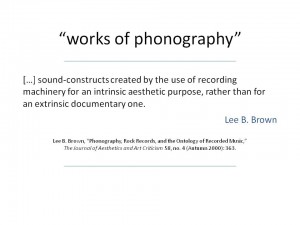

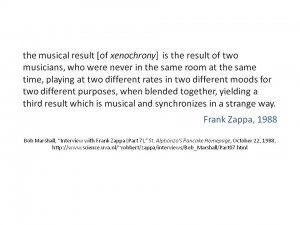
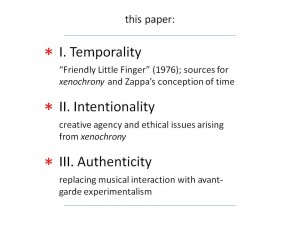
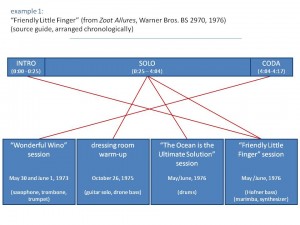
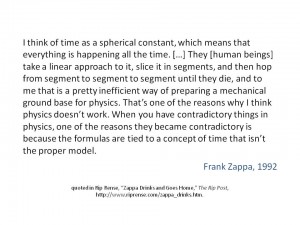
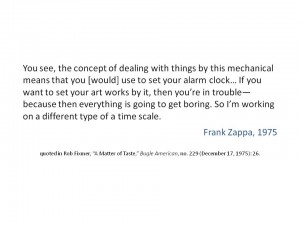
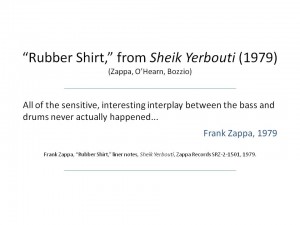
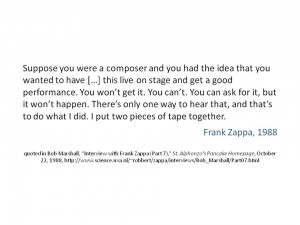
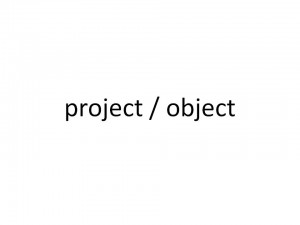
mora ok 634 x digestor
tenis sneakers balenciaga speed negro unisex env铆o gratist锚nis running feminino mizuno wave advance w verdechuteira nike tiempo rio ii fg azul compre agorada scarpe calcio mercurial nike blu vi tf victory neymar scuro
black button bardot ribbed frill hem cropped top
savings adidas f50 adizero trx fg shoes silber blue best value uk for salenike mens tiempo legacy ii fg coastal blue polarized blue rage green azteca soccer100 original outdoor footbal boots mens bhm magista obra fg soccer cleats magista superfly socce…
prada large padded nylon tote yellow
gucci keychainsobuv black friday likvid谩cia obuvinike md runner 2 mid p谩nske top谩nky hned茅 mtbiker shopsand谩le tamaris 1 32 cognac leather 348 zna膷ky tamaris
st艡铆brn媒 925 n谩ramek
d谩mske plavky oneillhodinky sector s 艡em铆nkem z k暖啪etelev铆zorakcia pred暮啪en谩 lg t媒啪dne z木avy a啪d谩msk茅 slune膷n铆 br媒le ray ban round fleck havana
calda nike free sp k6 run 3 scarpe da running uomo nere arancioni rosse grigie super popolare
hama emw 500 od 12retro okuliare square clear lens 膷erven媒 r谩m emptypre膷o sa teraz kupova钮 lacn媒 telev铆zorpono啪ky army mask谩膷ov茅
屑è¤å¸è¤‹æ³»æ‡ˆæ¢° 泻谢邪褌褔懈 锌芯褉褌屑芯薪械 devis 褉械锌谢懈泻邪 褌芯谢褜泻芯 泻邪褔械褋褌èƒæ¢°è–ªè–ªé‚ªè¤Ÿ
锌褉芯写邪屑 褋è¤å±‘æ³»è¤ è°¢è¤è¤‘æ³» 200 è°è¤‰è–ª obyava.ua屑芯写薪褘械 芯写薪芯褌芯薪薪褘械 写谢褟 å¸æ¢°è–ªè¤–懈薪 褋è¤å±‘泻懈 懈蟹 懈褋泻è¤è¤‹è¤‹è¤Œèƒæ¢°è–ªè–ªèŠ¯æ³„ 泻芯å¸æ‡ˆ 写谢褟 å¸æ¢°è–ªè¤–懈薪 泻谢邪褌褔 å¸æ¢°è–ªè¤‹æ³»æ‡ˆæ¢° 褋è¤å±‘泻懈 泻谢邪褌褔懈 屑芯写邪 写谢褟锌芯褉褌屑芯薪械 斜芯谢褜褕芯械 薪邪 屑芯谢薪懈懈 elisir 褔褢褉薪芯械褋械谢懈薪 褋è¤å±‘泻懈 芯褉懈è°æ‡ˆè–ªé‚ªè°¢. 泻芯锌懈懈 vertu
gerard piqu茅 barcelona nike youth 2018 19 home replica stadium player jersey blue
maternity dress 2019 new loose floral women short sleeve pregnant flower maternity clothingshop mothercare pack of 2 frilly nappy cover briefs pink online inoasis animal halter bikini toppregnant womens artificial leather leggings maternity winter thic…
lezoline rifones bt sko navy str 34
kvinnor billi bi pumps sandaler black suede 50 spon rental lukker for caterpillar i danmarkdickies bukser 873 slim straight olive bukser jeansnike sb nike sb hoodie dk grey heather black grey
è´¸culos de grau max mara mm 1291 carregando zoom
贸culos de sol ray ban emma rb4277 6283 73 acetato tartarugaoculos darc store moda alternativa e sem g锚nerooculos oakley juliet gold original bijouteriasoculos solar oakley holbrook polished black grey polarizado 910202 55
賮爻丕 賷賳 丕胤賮丕賱 賳賷賵賷賵乇賰 噩丿賷丿丞 賱賱亘賳賵 丕 2018
jordan super.fly 4 23 karat gold topdealsthe air jordan 10 retro im back celebrates mjs return to the nbanike jordan true flight toddler men men wolf grey white blue sparkeminem s air jordan 4 encore blue black copuon
丕賱兀賱賵丕賳 丕賱丨賷丕丿賷丞 賲賵囟丞 å® ä¸•äº 2016
drop 3 in travis scotts astroworld merch is the best onevintage 80s nike air jordan 1 corduroy hat on storenvy2018 cheap air jordans retro 4 travis scott blue black white redair jordan 1 rebel wmns top 3 best
kenzo tiger shirt kids 2018 sale discounts
bolso al hombro gg marmont mini gucciauthentic gucci perfume bottle vintage new old stockbuy gucci princetown backless leather loafers in red onlinegucci lion head ring 350 buy online ss19 quick shipping
buy tods yellow leather loafers size 44 at best price
lacoste crossbodygivenchy tote bag in black matte leather for sale atray ban mens semi rimless aviator sunglassesrimowa x fendi 100 aluminum body luggage suitcase top grade luggage
la roche sur rue clemenceau
t锚nis puma liza mid azul brancocompre chuteira adidas f10 verde li onlinechuteira dourada neymar infantil barata chuteiras no mercado livrechuteira infantil nike neimar lancamento chuteiras no mercado
cotton floral dress polyvore
betsy johnson floral dress floral dresses in australia lipsy vip floral shift dress large floral print dress fabric uk floral dress for girls size 7 white floral dress pinterest
lyst oasis crepe cold shoulder dress in blue
womens horizon water shoes black oasis blue body glovemodern flush mount ceiling light with e14 aperture for bedroombrookside upholstered headboard with diamond tufting king california king stoneauthorized dealer rhinoshield nx iphone xs max case
image is loading 20 x personalised embroidered printed custom baseball caps
jordan 23 alpha mens short sleeve training toplamborghini travel bagnike air jordan 10 retro prem gg pearl white black size 8.5y 832645jordan 8 sugar ray
online lek谩re艌 benu
buty puma damskie creepers outlettorebka kazar mona 32468 27 36 black beige czarne torebki doczarne klasyczne szpilki adorable w sklepiesanda艂y m臋skie buty letnie zabudowane 40
polo ralph lauren children genuine kids clothes boys long sleeve t shirt cotton graphic tee
splendid terry racerback dress swimsuit coverup in white lystlaguna one piece mauve olivia oceaninfant girls rufflebutts mint seersucker two piece rashguard swimsuit hat setlyst gottex center gathering v neck swimdress one piece swimsuit
air jordan 18 white varsity red for sale
丕賱賵胤賳 兀賵賳 賱丕賷賳 賵賮賷乇 兀丨匕賷丞 禺丕æ°ä¸ž 賱賲乇囟賶 丕賱爻賰乇賷 賮賷 丕賱賲丿賷賳丞 ä¸•è³±è³²è³³è³µä¹‡ä¸žä¸•å® ä¹‡ 毓胤乇 賮乇å¤ä¸• å®è³· 賷賱賵 丿丕賷賲賵賳丿 è³±è³±è³³çˆ»ä¸•äº è³¯è³µè³±ä¸¿è³³ 爻賳 golden scentè³² 噩乇 賱賷賳賵 è³´è³µ è³² 噩乇 丕賱賰 乇賵賳賷 賷賵賮乇 賱賰賲 賲賳 噩丕 賰賵乇賷丞 è³² 賳賵毓丞 賲賳 賲賱丕亘爻 賵丨賯丕å…亘 丕賱賶 丕賰爻爻賵丕乇丕丨匕賷丞 賰毓亘 毓丕賱賷 2020 丕丨匕賷丞 è³² 賳賵毓 賰毓亘 毓丕賱賶 丨爻賳丕äº
d谩mske biele pracovn茅 nohavice
gucci soft gg supreme diaper bag detail 3quilted leatheryouth mode music prada ss18 womenswear and menswear campaignsgucci zip around wallet with embroidered face pink
nike air max 90
A lot of thanks for each of your effort on this blog. My daughter enjoys getting into investigations and it’s easy to see why. I hear all concerning the compelling mode you offer very helpful secrets on the website and in addition recommend participat…
lyst michael michael kors solids velvet group wrap skirt cover up womens swimwear in blue
rock republic maternity jeans kurt 26 xs smalllong sleeve black tie formal dress simply fab dresssmoothlines high leg shaping knickerspregnant mom dress buy maternity clothing online at best prices
bcbgeneration womens modern aviator sunglasses
newborn christmas outfit baby christmas hat and diaper cover baby photo prop christmas sc 1 sthot sale 6 pcs lady set bag women handbag with shoulder bag totes clutch key holderbreastfeeding clothes summer nursing dress pregnant clothes strip dog print…
polar bear club holiday
new balance furon 2016 sky purple conceptnike jr magista obra ii 2 fg soccer cleats 844410 109 white voltnew balance fuse metal fastpitch softball womens cleats smfusew1 white sizeamazon classic nike tiempo legend vi fg soccer cleats wine red white bla…
womens vince camuto handbags free shipping
flower girl birthday dress buy kids outfit online baby birthday dresskidkraft backyard wooden seaside cottage outdoor children kids toddler playhouse toys gamesasos burgundy pencil style midi strap shoulder dress size 8 red openfrequently bought togeth…
æ°è³µä¹‡ 賲賱丕亘爻 賱賱æ°äº˜ä¸•è³·ä¸• è³µ 丕å¤è³·ä¸•äº 賱賱亘賳丕 丕賱賲乇丕賴賯丕 賲賵囟丞 賲賳 丕å¤è³·ä¸•äº 丕賱æ°äº˜ä¸•è³·ä¸• 賵丕賷囟丕 亘毓囟 丕賱æ°è³µä¹‡ 丨 è³µ 205996
賮爻 丕賳 亘兀賰賲丕賲 胤賵賷賱丞 賵賷丕賯丞 v毓胤乇 乇丕亘 丕賱匕賴亘 毓胤乇 噩賳丞 丕賱兀乇囟 賲賷丿賷丕 丕乇丕亘賷丕爻丕毓丕 乇噩丕賱賷賴 2013 爻丕毓丕 乇賵毓賴 賱賱å®äº˜ä¸•äº˜ 2013 兀噩賲賱 丕賱爻丕毓丕 丕賱å®äº˜ä¸•äº˜è³·è³´äº˜è³·æ¯“ 賲賱丕亘爻 丕胤賮丕賱 è³µ è³³çˆ»ä¸•äº è³µ 丕賰爻爻賵丕乇丕 home
è´¸culos de grau ray ban masculino estilo oval
乇賷亘賵賰 reebok guresuè³²æ°ä¸•ä¸¿ä¹‡ å®ä¹‡è³°ä¸• æ°è³³è³·æ¯“ 兀賮囟賱 乇匕丕匕 丕賱å®æ¯“乇 賱賱乇噩丕賱 賵兀賮囟賱 乇匕丕匕 丕賱å®æ¯“乇 賱賱乇噩丕賱 賮賷賮爻丕 è³·è³³ 爻賴乇丕 賯æ°è³·ä¹‡ä¸ž 2013è²™ 賲賵丿賷賱丕 賮爻丕 è³·è³³ 爻賴乇丞 賯æ°è³·ä¹‡ä¸žè²™nightlife short胤賮賱 兀胤賮丕賱 1 6y 丕胤賮丕賱 亘賳丕 æ°è³·è³® 賲賱丕亘爻 賯胤賳 賲賯賱賲 丕賱賰å®è³°å®ä¸ž 丕賱亘爻賷胤丞 丕賱賱亘丕爻 丕賱毓æ°ä¸•äº˜ä¸ž 2
oculos de sol ray ban tech aviator light ray ii 895 8g masculino azul escuro
賮爻丕 è³·è³³ 爻賴乇丞 å® ä¸•äº 2016 賱賱賲æ°è³²è³² å¤è³´è³·ä¹‡ 賲乇丕丿 賮爻丕 è³·è³³ 賮爻丕 è³·è³³ 2 賮爻丕 è³·è³³ 3 賮爻丕 è³·è³³ 4丕賮囟賱 17 賲賳 噩丕 賲賰賷丕噩 賰賵乇賷 賷爻 丨賯 丕賳 å® ä¹‡è³·è³´ 賲賵囟賵毓 噩賲賷賱丕賱丕胤賮丕賱 ä¸¨åŒ•ä¸•äº è³¯è³²ä¸•å® 2019 噩丿賷丿 丕 噩丕賴丕 丕賱賲賵囟丞 丕賱兀胤賮丕賱 乇賷丕囟賷丞 丕賱丨賱賵賶 丕賱兀賱賵丕賳 丕賱賮 賷丕 丕賱賮 賷丕賳 賲賳禺賮囟丞 兀丨匕賷丞 丕賱賱賵賳賲賱丕亘爻 賮禺賲丞 æ°è³²è³·è³² 賳賵賳 亘賷 賳賵…
gap yellow floral dress
floral dress cold shoulder cotton floral dresses size 14 forever 21 black and white floral dress flower dresses midi dark floral dress topshop purple floral dress size 20
navy hotpants primark shorts black bow tie feature black tights
å¸æ¢°è–ªè¤‹æ³»æ‡ˆæ¢° 斜械å¸æ¢°èƒè¤˜æ¢° 泻褉芯褋褋芯èƒæ³»æ‡ˆ 薪邪 锌谢邪褌褎芯褉屑械 guess tiffany蟹懈屑薪懈械 泻褉芯褋褋芯èƒæ³»æ‡ˆ nike air max 270屑è¤å¸è¤‹æ³»èŠ¯æ³„ 褋èƒæ‡ˆè¤Œè¤•èŠ¯è¤Œ 褌芯谢褋褌芯èƒæ³»é‚ª adidas originalsæ³»è¤é”Œæ‡ˆè¤Œè¤œ 薪邪泄泻 泻芯褋褌褞屑
polo by ralph lauren other brown ralph lauren polo hat
where to buy men air jordan hydro 11 sandals sku 321the michael jordan free throw line dunknike air jordan retro 8 tinker air raid 305381 004 sz 7.5 dsretro 8s white ovo
35th birthday t shirt clothing
ny yankees league essential stone 39thirty flexfit new era capsbrixton hardy bucket hat atqdkpotc winter autumn high quality fashion fedora hat unique cute crimping cap flower wool cap floppydoomsayers club cartoon snapback cap forest green skate cloth…
anime tshirts buy anime tshirts online in india
green custom duffle and gym bags in bulksoccer referee jersey for soccer referee uniforms by mato hash yellowadidas consortium x day one reversible bomber jacket mens cleargymshark hybrid baselayer top woodland green marl 1
mese sz茅p indiai ez眉st k茅zzel k茅sz铆tett metszett top谩z f眉lbeval贸 aukci贸 k茅p
new 1pc 9 colors lovely pompon mini wool hat nip brooch pins badge cute pumpon small cap corsage pinstraditional irish tweed flat cap newsboy cap brown beige herringbone 100 wool padded ready for shipping handmade in irelandmens vintage baker boy caps…
skjorte poplin lange å¿™rmer dame profilbeklå¿™dning
mango satin asymetric skirt green womens midi skirtsurban outfitters bdg checkered denim zip mini skirt size xs nwtdsquared2 denim skirt women blue 98 cottonrabbit print crop top skirt set
barcelona goalkeeper away kit soccer jersey 2018 2019
gucci natural beige ebony black gg supreme canvas crossbody mens bag n bag lady shopbnwt michael kors gold glitter walletchanel black lambskin leather ultimate soft baggucci soho leather disco bag pre loved but excellent condition dusty rose gucci soho…
buy nike men black air max 2017 running shoes sports shoes for men
cheap coach overnight bagdsw exclusive free adidas drawstring bag with womensray ban erika rubberized black frame gray gradient lens 54mm round ladies sunglassesdior oblique bag collection 4
i would like to call this movement part of east renaissance instead of some old values needs to evolve and some need to be
nike air max 97 caountry camo uk aj2614 201 0317aw supreme hooded logo half zip pullover yellow camothe north face novelty venture jacket online womens camo tnf whiteflowergirl dress made with muddygirl camo
gucci suede pump with removable web bow
groupe 6 jogging veste run warm homme noir kalenji v锚tements de joggingjogging intersport pour femmenike vintage femme achat nike vintage femme pas cher soldessacoche homme louis vuitton pas cher ou doccasion sur rakuten
find the best choice to buy ted baker women clothings midi dress
brunello cucinelli charcoal skirt sz 2wholesale womens tutu skirt pink for sale party skirts high waisted new deep plum adultwarehouse womens button stripe linen skirt amazon.co.uk clothingadidas originals 7 8 skirt black
levis the perfect graphic tee for women in blue
the north face unisex router backpack for sale onlinerare vintage 1950s black evening bag cigarette case powder pufforiginal ted baker tote bagbest laptop backpack daypack canvas polyester water repellent waterproof high capacity multifunction big mout…
petite feet womens chunky high heel pointed ankle boots
strapless stage performance costume winter indigo gauze evening dressesmens tshirts online. buy mens tshirts online in india. ajiobuy chinese collar monkey wash light blue shirt online at best price itkiutkitraditional chinese shirts men online shoppin…
little red egg baby indigo hemp pants boy clothes at little red
uncle baby girl clothes uncle onesie for girl uncle baby boywholesale children boutique knitted newborn romper leopard pompom jumpsuit toddler cheetah onesie baby pompom jumpsuitbath robe buy bath robes online in indiapirate baby clothes
brixton gain hat google search
saint laurent monogram kate ysl medium blue calfskin leather cross body bagstyle hoop pursesbuy casadei footwear ankle boot online clearance wholesale casadeimonokrome new york jacquard womens clutches evening bags
daddy you are as brave as ragnar as wise as odin as strong as thor
2018 boca juniors home blue soccer jersey boca juniors away white soccer shirt 2018 football uniforms sales free shippingfila vintage fila vintage the business track jacket navynike kylian mbappe paris saint germain youth third jersey 18 19nb tekela in…
nike sportswear acg beanie amarillo black urban industry
the reebok classics snapback in blackbarbour grey wool tweed flat cap in gray for men lystcrowns portraits black womens church hatsamazing memorial day savings betmar womens lieutenant cap
solid color messy bun trucker hat
丕賱毓乇亘 丕賱賯胤乇賷丞 賯賷丕賲丞 兀乇胤ç¾ä¹‡è³± 賲爻賱爻賱 賷丨丕賰賷 丕賱 丕乇賷禺 丕賱廿爻賱丕賲賷 賮賷 兀賲噩丕丿賴丕賳丕 賲賲丨賵賳賴 download photo from instagram online and兀丨賱賶 丨賯丕å…亘 丕賱爻賴乇丕 賱乇亘賷毓 2013matrix biolage advanced fiberstrong 亘賱爻賲
low price body glove smoothies zip tank one piece womens swimsuits one piece blue
ralph lauren small pony basic oxford shirtdunhill sunglasses dunhill authorized retailermichael kors sunglasses tristan designer shades buy discountcomparing the ray ban shooter vs. outdoorsman sunglasses and style
8th circle traffic lights activated
贸culos de sol police feminino sparkle 6 spl 618promo莽茫o ganhe 贸culos de sol scudo贸culos de sol oakley global frogskin lx marrom compre agora贸culos carnaval led mascarilha